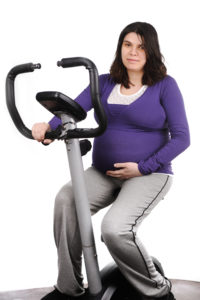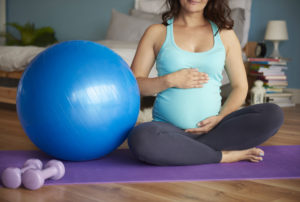Exercise during pregnancy is controversial. For much of recent history, pregnant women have been treated as if they had an illness and were subjected to a state of confinement. Throughout history, mothers-to-be have been told to cut back on exercise and take it easy, despite the positive effects of exercise on body and mind.

Pregnant women were advised to relax, avoid strenuous exertion, and minimise stretching and bending for fear of strangling or squashing the baby. Even in the first few months, when your body remains bump-less, some people will knit their brow and take a sceptical breath if you say you intend to remain active. You will be warned against lying on your back, swimming anywhere but a pool, lifting anything heavier than a feather and putting any sort of pressure on your joints.
But is any of this based on evidence?
According to the charity Tommy’s (which funds research into miscarriage, stillbirth and premature birth), many women still fear that exercise can lead to miscarriage.
Clapp (2002) showed that exercise in pregnancy DOES NOT
- Increase the incidence of miscarriage or birth defects
- Increase the incidence of premature labour or membrane rupture
- Alter the quality or quantity of breast milk
We now better understand women’s bodies and recognise the effects of exercise during pregnancy as broadly positive
Physical Benefits of Exercise during pregnancy
The NHS, the Royal College of Obstetricians and Gynaecologists, the NCT and the National Institute for Health and Care Excellence all recommend moderate exercise during pregnancy, to alleviate or reduce the risk of
- gestational diabetes
- pregnancy-induced hypertension
- high gestational weight gain
- type 2 diabetes
- cardiovascular disease
Mental Health Benefits
The Royal College of Psychiatrists recommends exercise as a key factor in maintaining mental well-being during pregnancy, while recent research from the University of Southampton has shown that moderate intensity exercise is associated with lower rates of antenatal depression.
Robeledo Colonia (2012) showed that aerobic exercise training during pregnancy reduces depressive symptoms in nulliparous women.
Benefits for Labour and Birth
Exercise during pregnancy is associated with shorter, easier and less complicated labour and birth
So how much is OK …..and what type of exercise is recommended?
Walking
Staying active in your daily life is definitely a good idea. Take the time to go for a walk when you can. Gentle play with your children and pets will also be beneficial for your physical and mental health.
Running
You can carry on running while you’re pregnant if you were a regular runner before. However, if you didn’t run regularly before you became pregnant, now is not the time to take it up
Whether you’re pregnant or not, running can be hard on your pelvic floor. Personally, I would suggest that other forms of exercise are better options from 20 weeks onwards when the weight of the baby is putting more pressure on the pelvic floor.
Resistance Training
The official advice is to avoid any heavy lifting when pregnant, including children, if you have any. But, as many pregnant women know, this isn’t always practical or desirable!
Realistically, strength is very important in pregnancy. You wouldn’t run a marathon without doing some preparation, so why go into a marathon labour without getting your body ready?
Strengthening your abdominal, glute and back muscles can help prevent lower back pain that’s common during pregnancy.
Weight training helps you build stamina, which you need during labour and delivery.
Strength training throughout pregnancy can also help you keep your weight gain within a healthy range for your body. Mums-to-be can benefit from just about any type of weight training.
Free weights and resistance-training machines are good options.
If you lift weights already then bring the weights down as you go through your pregnancy.
If you have never lifted weights before, seek professional help from a qualified pregnancy fitness professional.
You can also do a simple weight-training program at home, such as exercises that use your body weight. Many women find that resistance bands are a convenient and inexpensive way to strengthen muscles.
Yoga
Yoga can be very beneficial during pregnancy, as long as you take certain precautions.
Yoga helps you breathe and relax, which in turn can help you adjust to the physical demands of pregnancy, labour, birth, and motherhood. It calms both mind and body, providing the physical and emotional stress relief your body needs throughout pregnancy.
Avoid poses that stretch the muscles too much, particularly the abdominals.
In general, these poses are safe in pregnancy:
- Butterfly stretch
- Cat-Cow
- Cobra (in the first trimester, if you feel comfortable doing this face-down pose)
- Seated forward bend (with modifications as described above)
- Side angle pose
- Standing forward bend (with a chair for modification)
- Triangle pose (with a chair for modification)
Avoid these poses:
- Backbends
- Balancing poses on one leg (unless supported by chair or wall)
- Camel
- Handstands
- Headstands
- Upward bow
If you are currently pregnant, and would like some personal advice as to what exercise is good for you in your pregnancy, please contact me to book a consultation

Rachel Law is a personal fitness trainer based in New Malden, Surrey. Qualifications: ActivIQ Level 3 Personal Training; Burrell Education Pregnancy Exercise Prescription; Burrell Education Advanced Pregnancy Wellness Practitioner; Burrell Education Advanced Post Natal Exercise Prescription; Burrell Education 3rd Age Women Optimal Health and Nutrition; Burrell Education Peri Natal Athlete; Burrell Education Pelvic Flow and Freedom; Olympic Weight Lifting; Premier Global Kettlebells; FIE Level Assessment and Mentoring






